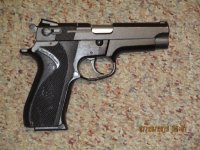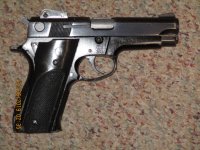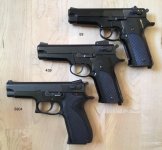Many good posts listing the differences between the 2nd gen 459 and the 3rd gen 5904.
The second most obvious difference is the integral front sight of the 2nd gen 459 vs. the dovetailed front sight on the 5904.
The number one most obvious difference is the grips.
Of course, every body sees that right off, and as soon as they pick them both up, everybody "feels" the difference and immediately ascribes that difference to the grips.
That is only "partly" true.
What few folks notice yet instantly "feel" (without being aware) is that the grip frame angle is different between the two generations.
S&W "straightened" (made more vertical) the grip frame front strap on the 3rd gens as compared to the more "angled" grip frame on the 2nd gens.
This helped reduce the circumference of the grip directly under the trigger guard.
I ran across this when I modified a set of 3rd gen grips to fit my 2nd gen pistol and also made a trial fitting of those 2nd gen grips on the 3rd gen pistol.
Here's the aforementioned thread:
3rd Gen grips on 2nd Gen Pistols (with pictures)
Here are a couple of pics from that thread showing the difference:
3rd gen grips on a 2nd gen.
Notice the angle of the front of the 3rd gen grips as compared to the angle of the front of the grip frame on the 2nd gen pistol on which they are mounted.
Some may wonder if the grips are not properly mounted, but look at the top of the grip and see that it is parallel to the slide.
2nd gen grips on a 3rd gen pistol.
Once again, observe the difference in the angle of the front of the grips to the angle of the grip frame.
The "uber-observant" will also notice that the 2nd gen grips are secured with a rubber band

.
That is because I didn't want to drill and tap the grip frame frame on the 3rd gen pistol for the threaded bushings for the grip screws.
Once again, look at the top of the 2nd gen grips and see that they are parallel to the slide.
By my reckoning, the difference in the grip frame angles is only about 2 degrees (72 degrees on the 2nd gens vs. 74 degrees on the 3rd gens) relative to the slide and barrel.
When looking at the pistols with their respective grips installed, practically no one sees it.
But when holding the pistols, practically everyone feels it.
BITD, S&W caught a lot of "flak" about the 2nd gen grip "blocky" feel ("Like a 2X4", many said), so they redesigned the grips to the one piece.
But they also made the change in the grip frame to reduce the circumference of the grips directly below the trigger guard, which also helped to change the perception.
John



